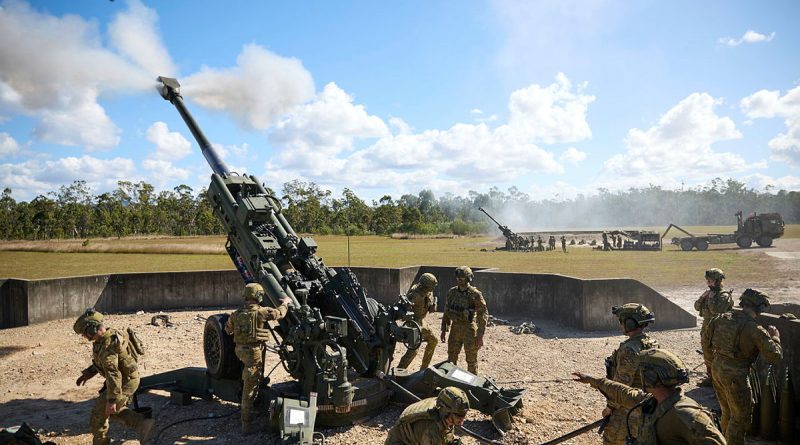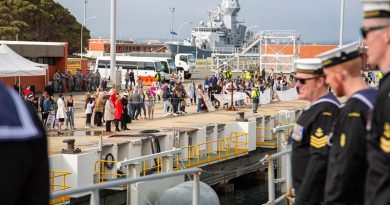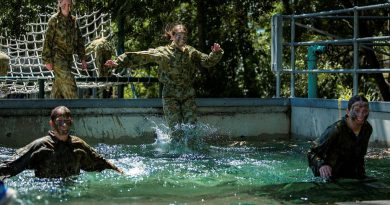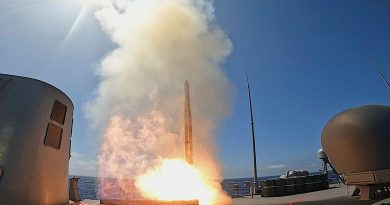Amphibious force ready for more

The Australian Amphibious Force (AAF) is one step closer to certification after completing Exercises Sea Explorer and Sea Raider.
CAPTION: Gunners from the 4th Regiment, Royal Australian Artillery, fire M777 howitzers in support of infantry during Exercise Sea Raider. Photo by Lieutenant Stephen Hunter.
Conducted over four weeks at sea and ashore near Bowen and Shoalwater Bay, Queensland, the Sea Series of exercises built the readiness of the AAF by integrating units from across the ADF to conduct large-scale amphibious operations.
The series began with Exercise Sea Explorer, during which more than 1200 personnel, four helicopters, 101 vehicles, including a troop of M1A1 tanks, and three military working dogs embarked in HMA Ships Adelaide and Choules.
Personnel practised the basic capabilities to manoeuvre, land and support forces from the sea to shore by helicopters and landing craft.
Providing realistic scenarios to certify and develop the ADF’s amphibious capability, the Sea Series ensures the AAF can provide the Australian government with the ability to rapidly deploy forces in response to a range of missions.

CAPTION: Australian Army soldiers and Bushmaster protected mobility vehicles are loaded onto landing craft for return to ship. Photo by Sergeant Andrew Sleeman.
Commander of the Amphibious Task Force Captain Phillipa Hay said it was important to maintain currency in a complicated military environment.
“With such a large amphibious force being formed from across all three services, there are a lot of moving parts,” Captain Hay said.
“The Sea Series of exercises allows us to continuously improve on previous years’ efforts, as well as continuing to sharpen our skills.
“Each individual plays a key role in the successful execution of amphibious operations, be they a sailor, soldier or aviator.
“I am privileged to co-command a force filled with the finest Australians who rise to the challenge.”
Exercise Sea Explorer was also the backdrop for this year’s major medical exercise – Hospex – which involved more than 40 clinicians, including doctors, surgeons, anaesthetists, dentists and pharmacists.

CAPTION: A simulated casualty is helped to a CH-47 Chinook from the 5th Aviation Regiment during a medical-evacuation serial. Photo by Sergeant Andrew Sleeman.
Hospex included multiple casualty transfers from ship and shore via landing craft and helicopters, major mass-casualty incident response training, and the embarkation of a veterinarian and robotic dog to familiarise medical specialists with the unique requirements of caring for military working dogs in the maritime environment.
Exercise Sea Raider exposed the force to a range of multifaceted challenges.
Layered scenarios provided commanders and the task force with a variety of competing priorities.
Commander Landing Force Colonel Douglas Pashley said there were fundamental difficulties building and maintaining the skills to effectively fight in littoral areas.
“This exercise has allowed us to build the readiness of the force – the latest chapter in the ADF’s amphibious journey,” Colonel Pashley said.
“We have formed a strong joint and multinational team that is capable of cross-domain operations in Australia’s archipelagic environment.
“While we have achieved real progress over the past few years, it is demanding and it requires regular and focused attention.
“The Sea Series has been an opportunity for our people to come together, establish trusting relationships, learn from each other, gain an appreciation for the littoral environment and to understand how each element can contribute to the objectives of the force across air, sea and land.”

CAPTION: An M1A1 Abrams tank leaves a Mexe-flote after being delivered to the beach from HMAS Choules. Photo by Sergeant Andrew Sleeman.
The force comprised various units and elements from across the Army, including more than 700 personnel and equipment from the 1st and 2nd Battalions, Royal Australian Regiment, as well as elements from 17th Combat Service Support Brigade, and 16th Aviation Brigade.
The AAF now pivots to Exercise Sea Master, nested within the overarching multinational Exercise Talisman Sabre.
.
.

.
.






The very reason for a country having a strong will and a strong, well practiced Defence Force is so the country doesn’t HAVE to use it. Unfortunately every now and again along comes a mad dictator or similar then its quite handy having a well trained defence force to lead rapid expansion using already established skills.
Bad things will ALWAYS happen, but they WILL happen when Governments spend less on Defence and more on just spending money on things they think will get them re-elected.
Please pass this on to our Government.
Can ANYONE advise me WHERE the A.D.F. is likely to make an opposed amphibious landing in the next 10 years?
No, I didn’t think so.
Can ANYONE advise me WHY the A.D.F. is likely to make an opposed amphibious landing in the next 10 years?
No, I didn’t think so.
Can ANYONE advise me HOW the A.D.F. is likely to make an opposed amphibious landing in the next 10 years?
No, I didn’t think so.
The A.D.F. lacks the location, the reason and the capability to do the above in a real 21st century Battle, so this P.R. Exercise is just a Sea Scouts Jamboree with Adult supervision, and bears no relation to any Operations in the next Decade.
One of the myriad issues with U.S. ‘Interoperability” is the A.D.F.’s slavish creation of Forces and Capabilities that have no use or need in Australia’s Interests.
DUTY FIRST.